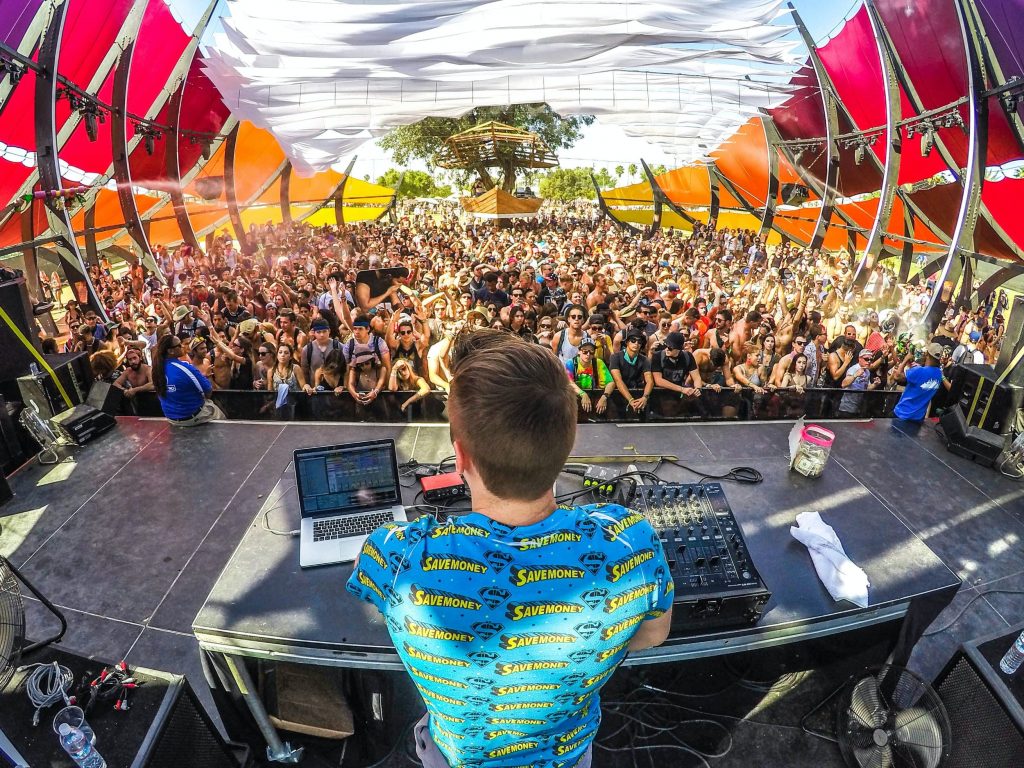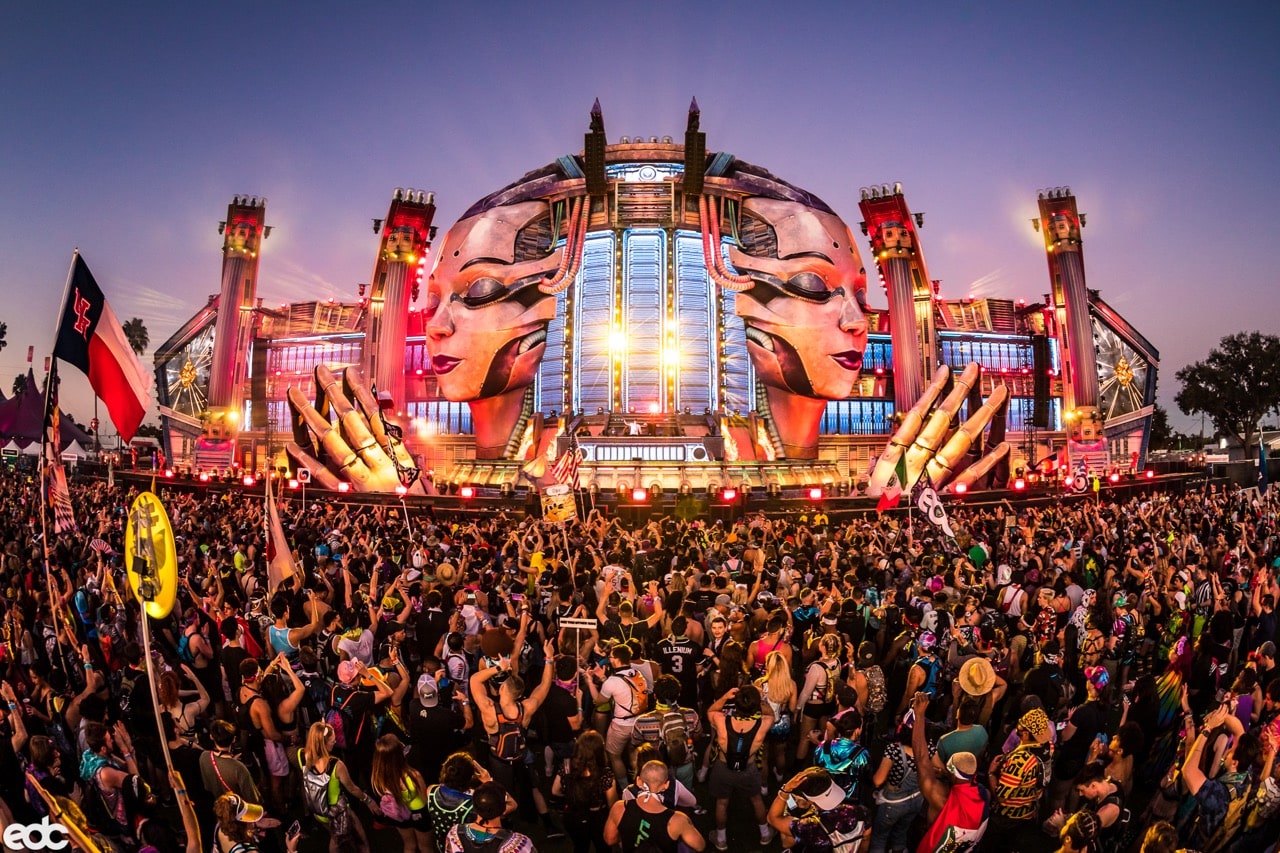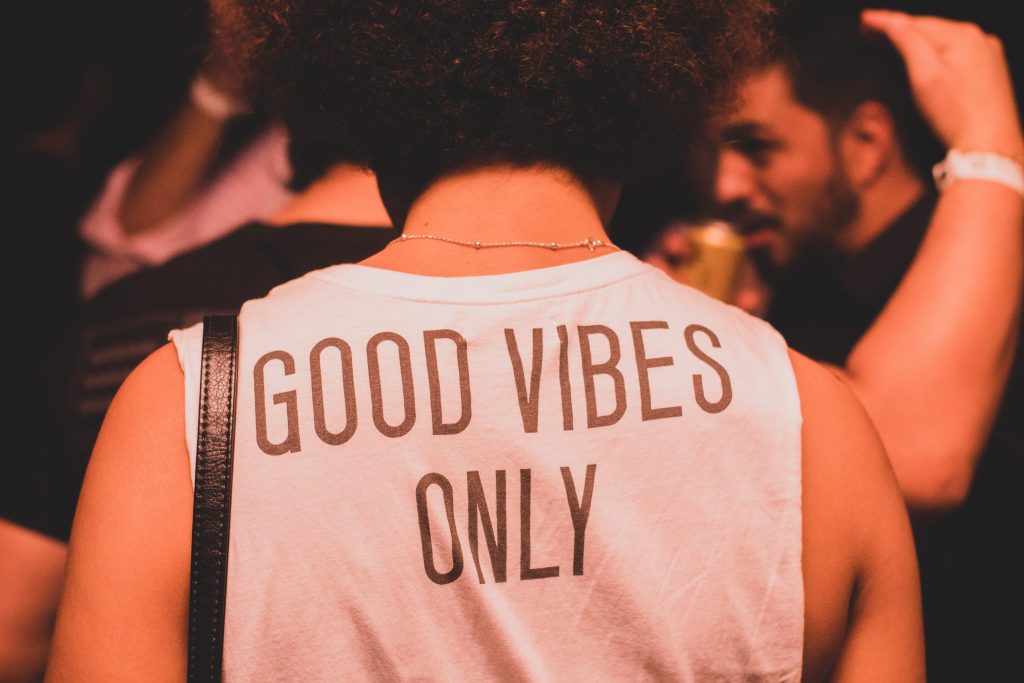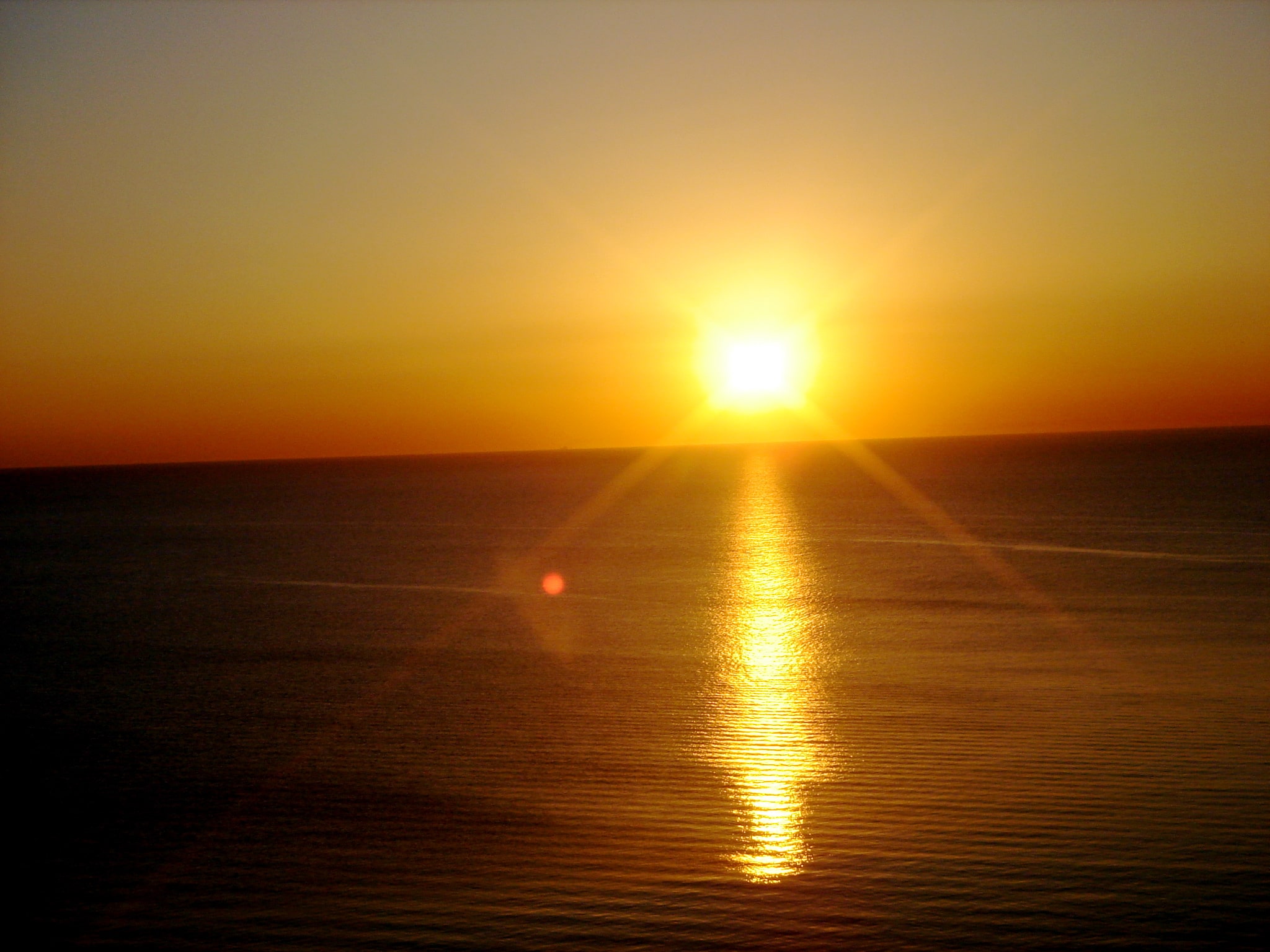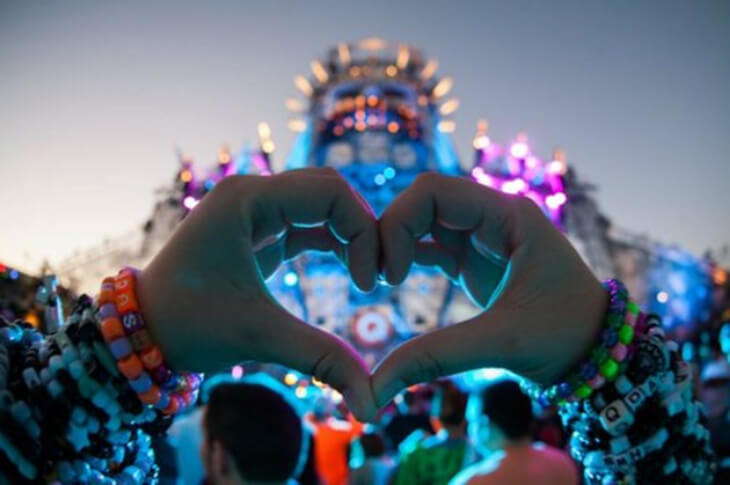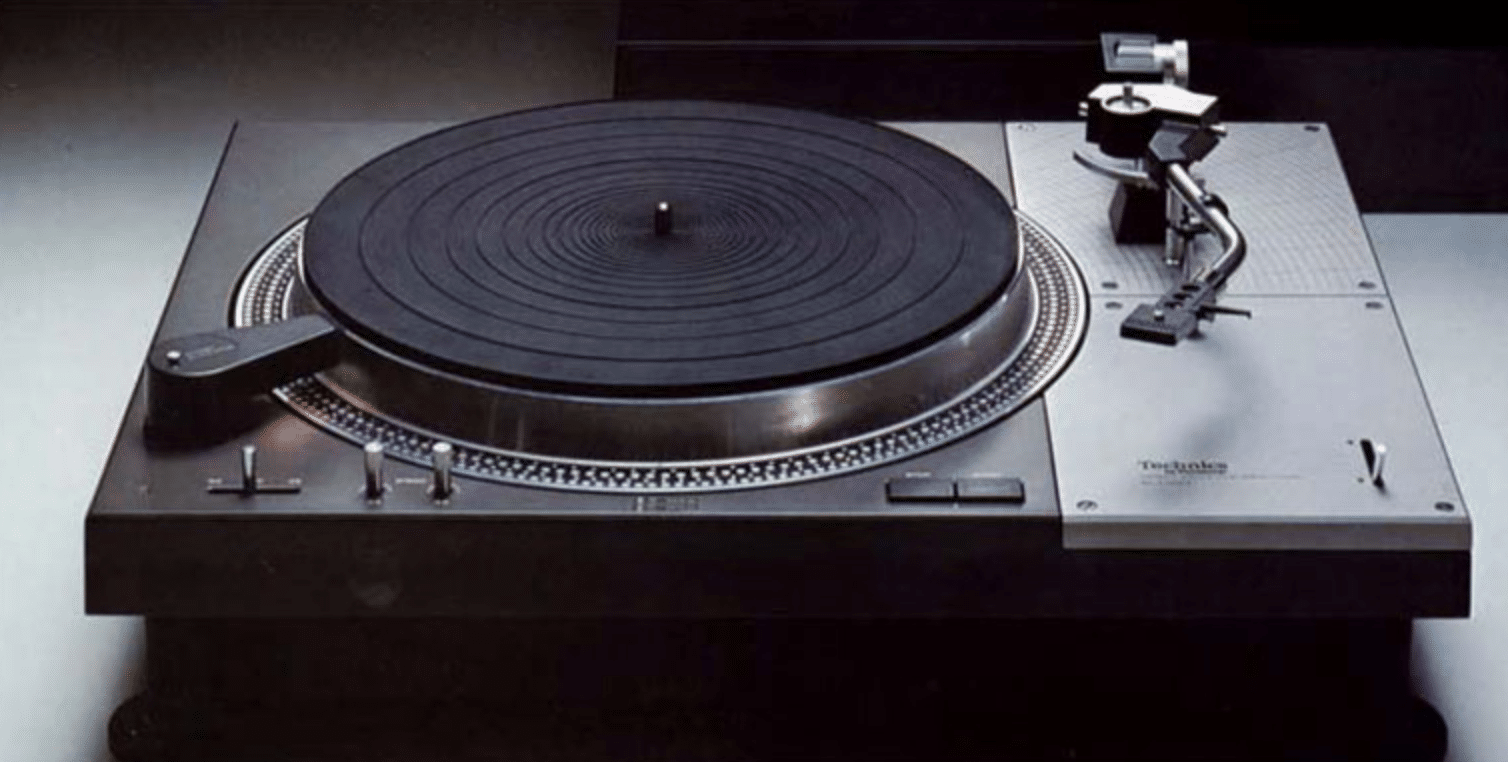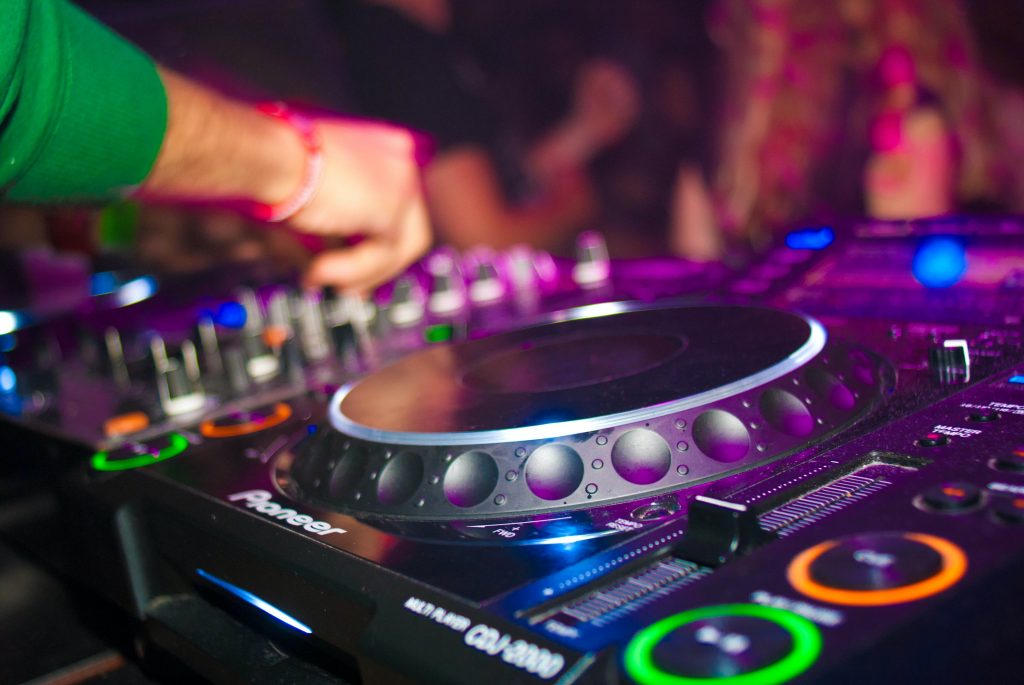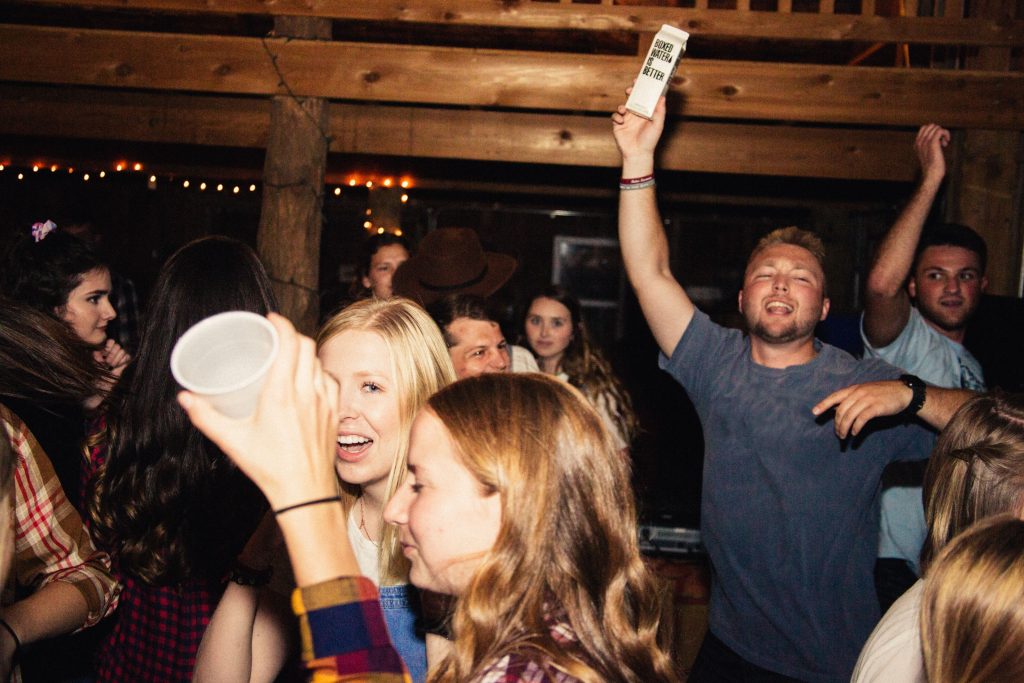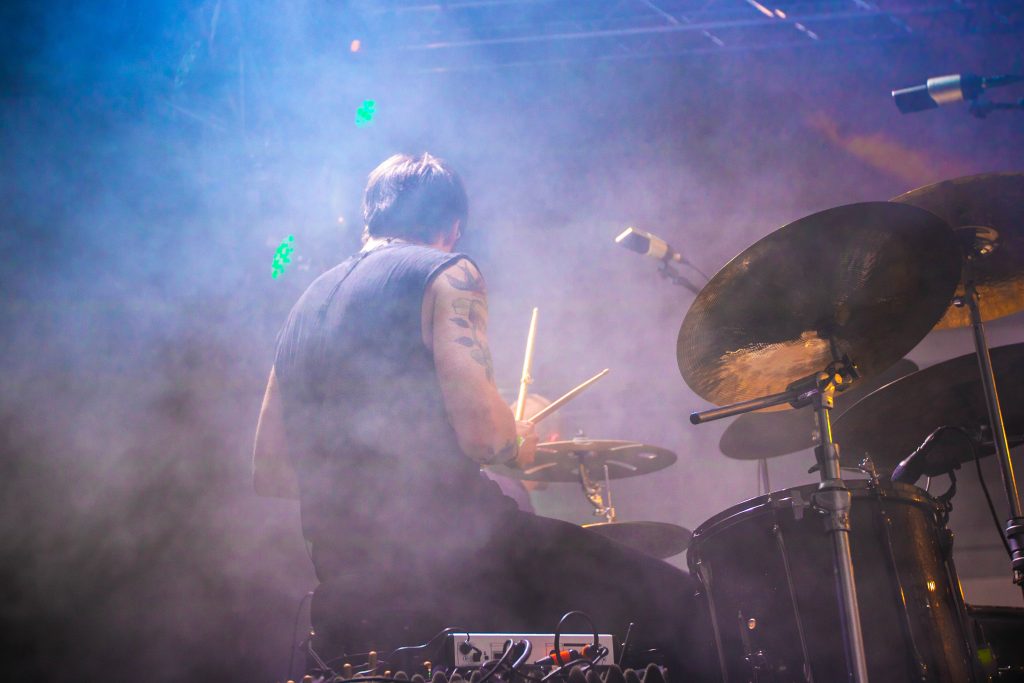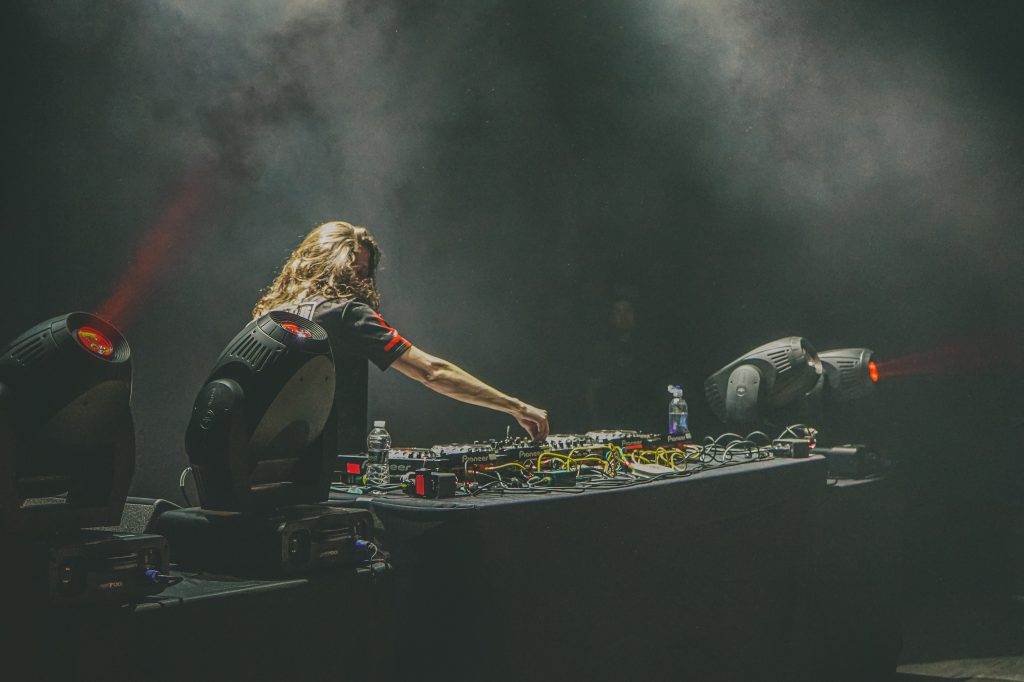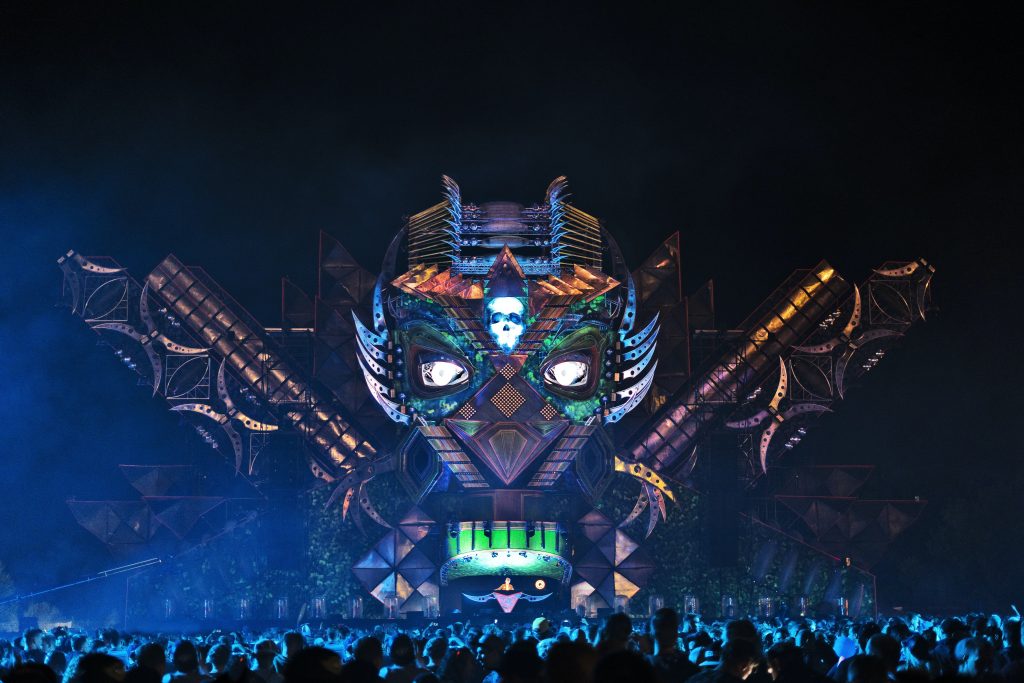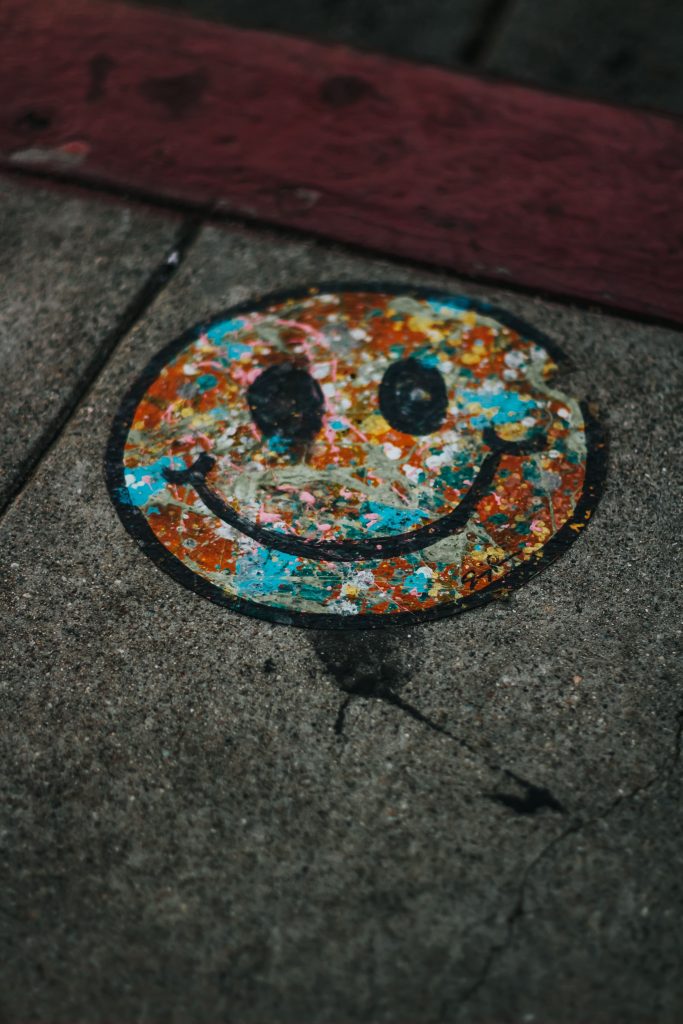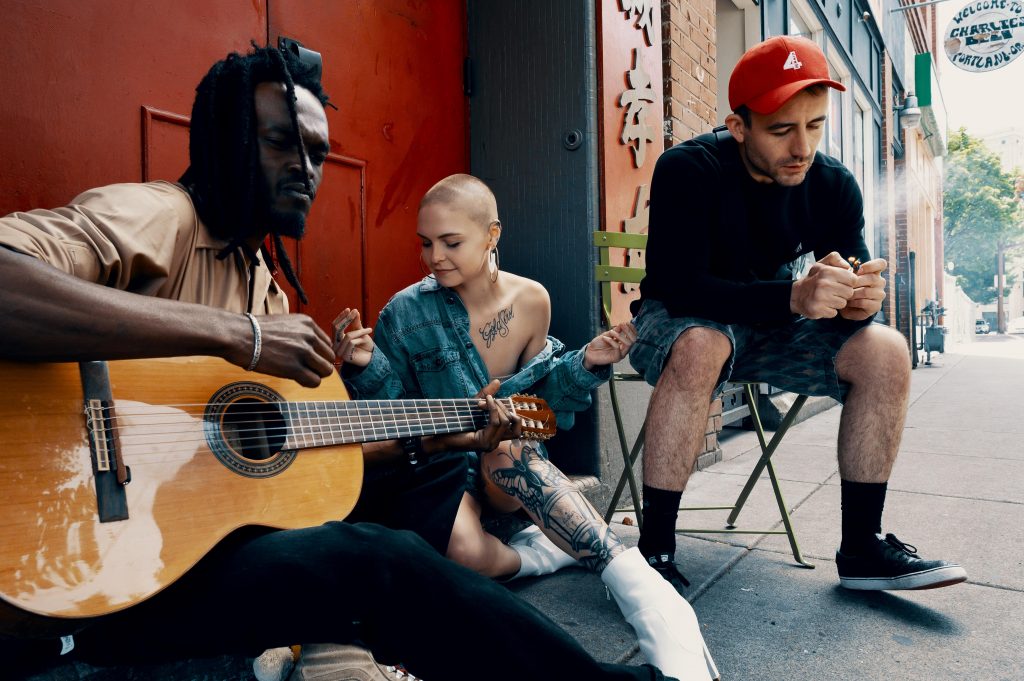27 Aug The History and Genres of EDM [Guide]
Welcome to the history and genres of EDM guide. Knowing the top most important genres of EDM is essential to navigating the nearly infinite sound of Electronic Dance Music.
If you’re a new fan of Electronic Dance Music wanting to know more about all of the wide variety of genres that exist, interested in starting your DJing career and want to educate yourself on the different types of EDM music, or simply looking to get friends tickets to an EDM show so they can experience something new then this guide is for you!
If you’re already an experienced raver and you are about to close out of this article, hold that curser or finger! To keep things spicy for you, I’ve also peppered in five fun facts about EDM I bet you’ve never heard of before. If you can honestly say you knew all of these footnotes in EDM history then I gracefully bow down to you. You truly are a rave knowledge god.
As a former newbie to the EDM scene, I once knew nothing about it and was curious to know more. I asked questions such as, “How did it start? What are the different sounds and genres? What additional tunes can I unearth today? How is it created and what instruments are used to make this music? What’s that thing DJs use to play music?”
Now looking back, I often get these questions from readers myself so I wanted to create an epic all in one place guide for you. Now you can get the answers to all of these questions and more with ease.
So, I booted up my computer and got hard at work researching the history and main elements of EDM and all of its genres. Since there are so many genres and subgenres of electronic dance music, I’ve decided to narrow my list down here and only focus on the top ten most important genres of EDM for you.
First, I break down the basics of EDM. Then I get into the tools of the trade. Finally, I go over the top ten most important genres of EDM and how you can recognize them when you hear them. I’ve even included music examples.
Just as EDM is an ever-evolving genre, so to is this guide. I will constantly be adding additional details here and how to spot the differences between them as the music scene grows and evolves. If you don’t see a specific sound you want to know more about or you want to let me know about a new and emerging EDM genre then please be sure to let me know by commenting below.
So, without further ado…
In This Article (Click on a section to quickly go to it)
What Does EDM Mean and Stand For?
EDM is an acronym that stands for Electronic Dance Music. The term applies to virtually every electronically produced song out there. However, not all Electronic Dance Music is the same. For example, Downtempo and Chill-step aren’t meant to be danced too yet they are still part of the EDM family. Video game soundtracks are also grouped into EDM despite the fact that dancing while playing a video game could result in you losing the game.
As a general rule, if the instruments used in a song are digital then the song is EDM. If just some aspects are digital sounding but not all then it’s probably pop or hip-hop.
How Many Genres of EDM are There?
In reality, there are so many genres and sub-genres of EDM it would be nearly impossible to cover them all. Beatport is the industry leader for downloading Electronic Dance Music and they list about 50 subgenres so that’s a rough gauge of how many current popular ones there are.
What I can tell you is there are roughly ten major big umbrella genres that most subgenres stem off of. Learning these ten umbrella genres will help train your ear to know generally what new subgenre you might be listening to which makes it a lot easier for your ear to eventually understand and digest.
When Was EDM Created and How Did It Evolve?
Many people will tell you EDM was created sometime in the early ’80s. Thankfully, we’re not ‘many people’. In reality, the ’80s are when EDM left its parents basement and started gaining mainstream popularity.
Many European countries, Germany in particular, were experimenting with futuristic and synthetic sounds during the 1960s. This brings us to our first fun fact!
Fun Fact #1. The current contender for the ‘first EDM song’ was made by Eimert and Stockhausen in 1955. It was titled “Gesang der Jünglinge” which translates in English to “Song of the Youths”.
After its arrival in the Dutch areas of Europe, EDM would take refuge in Ibiza, Spain for a while. Over the next decade or so the free spirits of Ibiza would dance to EDM on Spain’s picturesque beaches while the rebellious student’s movement in Germany danced to early techno in warehouses at night. These early raves are where EDM hid until the U.K. popularized the genre on a more global scale in the 1980s.
EDM can trace its roots to Funk, Jazz, RnB, big band music, orchestra composition, Rock n’ Roll, new age, and even traditional spiritual music from nearly all cultures.
Since producers of EDM come equipped with computers instead of instruments there’s virtually no genre it can’t reach. That said, there are some characteristics of EDM that are steadfast.
What is EDM?
The most common element of EDM is the use of synthetic instruments. These instruments are set to heavy distortion creating ‘futuristic’ sounds. These are the ‘beeps’ and ‘boops’ if you will. The use of heavy bass lines, wobble bass, and reverse bass, are also common features of EDM. As well as, a multitude of drum loops that are usually used to keep the time in an EDM song.
There is often little to no vocals in EDM. When lyrics are used they are often a means of furthering the rhythm. Lyrical lines are usually sampled onto a laptop, altered, and looped throughout the song almost like an alternative percussion instrument.
Of course, a lack of vocals isn’t a steadfast rule in EDM. Genres like Grime, Trap, and House have been known to incorporate vocals including rap verses, short excerpts from an MC (master of ceremony), or use small vocal samples. Whereas, genres like Liquid Drum (DnB), Downtempo, Progressive House, and Vocal Trance, have been known to run whole lyrical passages by a lead singer.
Finally, one of the most important characteristics of EDM is the transitions. EDM is known for buildups, breakdowns, overlaps, and shuffling its many moving parts in an almost machine-like fashion. Depending on the genre, the very time signature is not safe from tampering in EDM. Each genre of EDM is known for a specific kind of transition. We’ll go over each of them in turn.
What Were the Traditional Instruments Used to Produce and Make EDM?
Traditionally EDM was defined by the use of the Roland TR 808 and 909 drum synthesizers. It was also defined by the use of the Roland TR 303 bass synthesizer. These days, modern EDM has made relics of these bulky machines. Their same effects, and many more, have been transcribed into computer programming. This means producers can recreate all the most important genres of EDM on just their laptops.
These days if a producer wants to find a sound not yet digitized then they would have to fire up their old synthesizing machines. The ability to create new tones is reserved for those who’ve researched music technology. Those with a talent for musical composition can still create a new genre of EDM, but they’ll have to focus on the music structure itself if they want to circumvent the synthesizer machines.
What are Turntables?
Turntables are where the art of DJing was first born. From 1971 and 1972 the Technics SL-1100 and SL-1200 turntables were specifically geared towards clubland but initially designed for home use. These turntables blossomed in the US Disco scene and later in the Hip Hop community.
There are so many famous DJs who used vinyl to “scratch” songs as they performed. Scratching is an art form in and of itself. Although it is primarily done more in Hip Hop these days, artists like Z-Trip keep the art of scratching alive and well in the dance music world.
Check out this dope set from Z-Trip during the Nocturnal Wonderland Virtual Rave-A-Thon.
What Is a DAW?
The most common tool in a music producers arsenal today is a digital audio workstation or “DAW” for short. A DAW is a software program that allows musicians to record, edit and produce music with just a laptop. This has made music production convenience and affordable to the masses. There is a wide variety of different DAWs on the market but the most popular ones used in electronic dance music are Ableton, FL Studios, Logic, Pro Tools, and Studio One.
If you are interested in making music, some newbies start off messing around in Garage Band as it comes free with all Mac computers. I don’t recommend it for long term use but it’s a great option just to stick your toe in to test out the waters and have fun. It will give you an idea of different sounds are used in EDM as well by playing with the different sounds and presets.
What Is a DJ Controller?
A DJ controller is a board full of colorful buttons you see DJs playing with during their sets. These buttons can be linked to sound bites, drum loops, pitch effects, tempo adjusters, segments of the next song, and a whole bunch more effects. They have shrunk down in size since their early ancestors but have been a part of DJing since the beginning. They can include an electric keyboard, and or plastic disk(s) for emulating turntables which is where DJing first started.
Knowing how to properly use a controller is what separates a legendary DJ from some random guy with an iPod at a frat party. The industry standard is primarily the Pioneer CDJ 2000 controllers. Some DJs use two at a time while others I’ve seen use four. The more controllers the quicker you can switch and mix between multiple songs.
What Are the Different Types of EDM Genres?
With so many sounds floating around, it can be difficult to navigate the many names of EDM. Some genres are nearly identical with only two or three minor adjustments. Meanwhile, other genres break all the rules of EDM, because that was their intention from the get-go.
Thankfully the purpose of this article isn’t to show off all the facts we’ve looked up. Instead, it’s to help simplify things for you! Okay, and maybe show off a little along the way.
We made the list of the ten most important genres of EDM based on the main branches of electronic dance music. We gathered the genres from which many subgenres have sprung and mixed them in with more modern sounds. We’ll give you a little bit of their history, how to pick them out of a crowd, and who is known for making each genre.
This guide covers the following umbrella EDM genres including House, Progressive House, Trance, Dubstep, Hardstyle, Drum N Bass, Hardcore, Minimalism, Trip-hop & downtempo, and Acid.
The History of House Music
House is one of the most familiar breeds of EDM. You’ve likely heard examples of it at house parties (duh), but also in movies, video games, and even on the radio. For me, House music is one of the most fun to write about because it’s one of the few American made genres of EDM.
House music’s birth name is Chicago House because that’s where it originated. Its creation is attributed to the late, great, Franky Knuckles.
Franky was a Chicago native, and DJ during the disco era. In 1982 he opened his own club called The Power Plant and in 1983 he famously bought his first drum machine. Franky combined the pulsating bass of the Roland 808 drum machine with his favorite disco cult classic, R&B riffs, and soul excerpts to create what we now call Chicago House.
Sadly, Franky Knuckles passed away in March of 2014. He was showered with many awards and honors in his life including a Grammy for best remix recording (classic). He was inducted into the Dance hall of Fame, Chicago Gay and Lesbian hall of fame, and also received a lifetime achievement award.
In his memory, we’d like to add one of his many honors onto our fun facts list.
Fun Fact #2. The city of Chicago renamed the street where Franky first DJed to Knuckles Way. The Illinois senator who helped push the idea was none other than future president Barack Obama. That’s right, Obama is an EDM fan.
House music went on to gain serious popularity all over the world. In England, it was reworked into Acid House which was subsequently worked into a multitude of other genres during the 90s. These genres, in turn, helped further develop nearly all genres of EDM. This early influence makes House one of the most important genres of EDM out there.
What is House Music?
One of the easiest ways to recognize house music is to look for the reworking of popular sound bites. This could be anything from vocal or instrumental melodies, to well-known lines from Movies, TV shows, and viral videos.
Producers of houses will take and typically alter these samples to sound futuristic, although sometimes they downgrade the sounds to make them caveman-ish. If they do the latter it is only to provide contrast to the synthetic instruments they play over the borrowed sound bites.
Another common technique is to loop a certain verse from a song and use it as an added layer of percussion. Producers of House, or its many subgenres, often play with sound in a similar fashion to a snare drum. They will rhythmically repeat a famous phrase like, “I am the danger- d- d- DANGER” to add emphasis to a transition in a song.
House music is characterized by the “four to floor” style meaning its almost always made in the time signature 4/4, or common time. Each beat is accented by a heavy drum or bass hit that helps you, the listener, know when to jump or bob their heads.
Melodies made with synthetic instruments, like the electronic keyboard, are certainly common in House. However, they’re mostly used for additional effects to help signal transitions in the drum synthesizer or add to the classic space-themed aesthetic.
House Music Subgenres
Subgenres of House music include Deep house, Progressive House, Electro House, Modern House, Acid House, Liquid House, and more.
House Music Artists and DJs
Noted artists of House music include Larry Heard, Jesse Saunder, Calvin Harris, Avicii, Diplo, Green Velvet, Daft Punk, Carl Cox, and many more.
Important note: Because of its popularity, nearly every major DJ has at least dabbled with some form of house music.
House Music Songs
An example of early style House music is “New For U” by Andres.
The History of Trance Music
There are few strains of EDM as popular in the world as Trance music. This genre traces its lineage back to German Techno, and British new age music. However, German Techno is arguably the father to most branches of EDM whereas the traits of new age music stand out more distinctly in the Trance genre. As a result, most attribute Trance’s creation to the British EDM scene in the mid to late 80s.
Some musical scholars argue the new age music in Goa is the true origin of Trance music, but to keep things simple we’ll defer to the traditional explanation.
The ‘goal’ of Trance music is to evoke the feeling associated with deep states of meditation or enlightened consciousness. In this way, it is very similar to new age music, which attempts to lead its listeners into the same state.
The key difference is that new age attempts to inspire a seated listener into a state of mind whereas Trance attempts to transcribe that same state of mind into sound waves.
Think of new age as the training wheels on a bicycle, and Trance as a VR simulator.
What is Trance Music?
Producers of Trance often start with a ‘soft’ central melody, played either on the keys or waveform synthesizer. The melody is ‘weighed down’ by several more variables. These can include drums, or a bass line, a deeper layer of waveform synth, piano, digitally reproduced strings and digitally altered vocals.
Trance music is known for its ‘mix-ins’ and ‘mix-outs’ aka intros and outros. When a new element is incorporated into a song it is often teased to the audience in order to build anticipation. Little snippets of a melody, or a small ‘bubble’ of bass, will let the audience know something new is coming. Drum rolls are also a common transitional tool.
Traditionally producers let this new sound stew for a few bars, perhaps adding smaller sci-fi sounds to help diversify one bar from the next. This building up of melodies is what traces Trance’s roots to Techno, which is the first genera of EDM attributed to this style. The key difference is the rate at which Trance adds more variables.
Finally, sometimes very suddenly, the excess is stripped away. This leaves either just the baseline or else the central melody, ‘float lightly’ over the heads of its listeners. In these ways, Trance music mirrors the state of someone who transcends the mortal coil and floats in an internal/celestial bliss.
The most common thing to do from here is to put all the parts of the song together, then bring it crashing down on the heads of the listeners. This technique is also known as a ‘drop’. The drop is very common. In fact, nearly every modern EDM song as at least one drop. This early incorporation of the drop is what makes Trance one of the most important genres of EDM to know.
Other key traits of Trance include melodies being played in a minor key and often times a lack of vocals. When vocals are included the samples selected are often female voices altered to sound ethereal and otherworldly. This is done to add to the mystic atmosphere.
Arpeggios are common in Trance music because they help to create a “wide feel” to the music. An arpeggio is just a musical cord, broken down into the notes that form it. In the case of Trance, these notes are looped through in varying patterns to add diversity.
Trance Music Subgenres
Subgenres of trance include Acid Trance, Classic Trance, Hard Trance, Goa Trance, Progressive Trance, and many more.
Trance Music Artists and DJs
Noted trance DJs include Tiesto, Arman Van Buuren, Paul Van Dyk, Above And Beyond, Cosmic Gate, ATB, and many more.
Important note: “Euro Trance” is not an actual genre of EDM. It is often used as a semi-derogatory term for over-commercialized dance music. Generally speaking, the people using the term are just showing their own ignorance since Trance music originated in Europe anyway.
Trance Music Songs
A basic example of trance music is “Only Road” by Gabriel & Dresden. This is a great example of the ‘floating’ aspect mentioned earlier.
The History of Dubstep Music
Its somewhat fitting that Dubstep has become one of the most important genres of EDM considering its humble origins.
Dubstep is the byproduct of the genres Garage and UK garage. Garage music was, and to a lesser degree still is, a platform for producers to experiment with different musical techniques.
During the heyday of the English EDM scene, several new forms of House and Techno were being born. The oversaturation of standard or ‘typical’ EDM songs drove producers to try something new. The result was a compromise.
Producers continued working on crowd-pleasing genres like Trance but experimented with different sounds in their free time. They included these experiments on the ‘B’ side to their cassette tapes. These strange new tracks were originally for the serious EDM fans. The earliest example of what became Dubstep was found in 1998.
As the popularity of these alternative EDM songs grew the music industry took note. Finally, in 2002 corporations looking to monetize on the experimental sound gave it the name Dubstep and the rest is modern history.
What is Dubstep Music?
Dubstep is an amalgamation of 2-Step, Dub Reggae, Jungle, and Broken Beat. Broken Beat is perhaps the most important aspect out of all of these. Broken Beat is a relatively short drum rhythm that allows producers to shuffle and syncopate drum loops with greater ease.
Dubstep often explores harmonic discord. Its producers experiment with the ‘roughness’ formed when notes that aren’t in the same musical chord are played simultaneously. The idea was to try and get yourself out of the strangest situations you could find.
As harmonic discord became more widely used, producers started playing with the rhythm and tempos of Dubstep songs. Basslines might spill over into extra measures. The time signature could be adjusted from one measure to the next to allow for a wider verity of syncopated rhythms. Essentially, everything was on the table for Dubstep artists. This makes Dubstep one of the few genres of EDM that doesn’t adhere to the ‘four to the floor’ style.
These elements make Dubstep a little jarring to new listeners as the mind tends to want to maintain familiar patterns. However, it also makes a song more gratifying to a fan since they will know when to expect sudden changes after hearing the song a few times.
The most distinctive trait in Dubstep is the use of wobble bass, sometimes called the wub machine. That’s the sound that goes ‘WUB WUB WUB WA WAAA”. Often the wobble base is the main means of moving the melody in dubstep. It plays a similar role to a singer’s voice or lead guitar.
The normalization of experimental techniques is what makes Dubstep one of the most important genres of EDM’s history.
Dubstep Music Subgenres
Subgenres of Dubstep include Brostep (Heavy Metal Dubstep), Parody Step, Thugstep, Luvstep, Bass Step, and more.
Dubstep Music Artists and DJs
Noted Dubstep artists include Skrillex, Bassnectar, Flux Pavilion, Borgore, Skream, Nero, Caspa, and more.
Dubstep Music Songs
A basic example of Dubstep is “Basshead” by Bassnectar.
The History of Drum N’ Bass Music
Drum N’ Bass is also commonly written as D&B and DnB.
As you can probably glean from the name, this genre of EDM pays particularly close attention to the percussive elements of its songs.
Drum N’ Bass grew out of the Jamaican Dub and Reggae scene that was blooming in the United Kingdom in the ’80s. These sounds fused together to form the genre Jungle in the early ’90s. By about 1995 the excess Reggae and futuristic sounds were stripped away leaving the Drum N’ Bass as the dominant factors.
Producers and fans who were looking to maintain the Reggae and futuristic elements in their songs founded another new brand of EDM, Drum N’ Bass. The Reggae, Techno, Jazz, and funk elements were slowly reincorporated back into DnB songs as a way of diversifying the genre.
Today, Drum N’ Bass is considered to be a fusion of Jazz and funk rhythms, with Rock N’ Roll beats.
What is Drum N’ Bass Music?
One of its most distinctive characteristics is its use of drum kits. While plenty of producers might circumvent the instrument for a computer program, most DnB artists like to incorporate ‘the skins’ into their sets.
The most common element used from drum kits is the cymbals. This is because prerecorded cymbals don’t carry the same ‘crash and echo’ that the live ones do.
The Jazz-inspired Breakbeat is also a very common element. Breakbeat is essentially a drum solo, or loop, that was played in a ’break’ during the music. During the digital age, Breakbeats were sampled and used as the main melody in for early Techno.
Breakbeats are important to note in DnB because they diversify the genre from Dubstep and other percussive heavy EDM. Many new ravers mistake DnB songs for Dubstep because of their shared elements, like the wobble bass.
If you’re unsure which one you’re listening to, focus on the drum loops. Longer patterns being repeated regularly indicate a song is DnB. Shorter drum loops being regularly swapped out means the song is probably Dubstep.
DnB is also a bit faster than Dubstep with about 30-60 beats per minute to be exact. So, if a song sounds like it had an extra cup of coffee this morning it’s probably DnB, not Dubstep.
Drumstep is also a common genre that gets thrown into the mix. Drumstep is as fast as DnB but utilizes the same half-step drum loops that Dubstep uses.
Producers of DnB will often lay down a drum beat, then syncopate it with a second drumline so that the two rhythms line up together like jigsaw pieces. Of course, there’s no rule that says a DJ can only use two breakbeats. A producer can use as many as they can handle. However, if they can’t line them up properly then they may have Drumstep on their hands instead of DnB.
Lining up the different breakbeats usually take the bulk of the song. Switching up between them is a defining characteristic of DnB so producers like to take their time with it.
DnB almost always uses common time, 4/4. It rarely plays with the time signature or the tempo of a song. The drum patterns are very technical and precise while the bass lines are where most of the experimentation occurs.
Sub-genres like Liquid Drum tend to make the bass line very funky. It allows for the bass to stray away from the tempo of the drum in a way that’s reminiscent of Jazz. However, the bass will always ‘walk’ itself back to the drumline.
Harder subgenres of DnB can do the same thing but it’s just harder to recognize because of the use of wobble bass. In this case, the bass line acts more like a guitar solo in a Rock N’ Roll song. The wobble bass has a lot of creative leeways but still has to end in rhythm with the drums.
Harder DnB also tends to use more full drum kits. Its fans tend to also enjoy Heavy Metal and other hard subgenres of Rock N’ Roll. This is why the merciless wailing on cymbals is more up their ally. The drum kits also allow for more drum solos to pop up in between the syncopated rhythms.
The diversity in sound is what makes DnB one of the most important genres of EDM. It can reach fans of but Funk Heavy Metal and help bring them into the fold of EDM.
Nearly every style of DnB is known for the use of sub-bass. Producers will pitch synthesized base notes to an extremely low timbre, somewhere between 60 hertz and 20hz. 20hz is about as low a tone as the human ear can perceive, but that’s fine. The real goal in DnB is to produce a bass line that the audience can literally feel. The low vibrations of the bass notes often roll through the floor and into the chest of its listeners.
Fun Fact #3. Drum N’ Bass is one of the few genres, of all music, with a history of being enjoyed by the deaf community since its percussive patterns can be felt when played through speakers.
Drum N’ Bass Music Subgenres
Subgenres of Drum N’ Bass include Breakcore, Jump Up, Ragga Jungle, Funkstep, Hardstep, Darkstep, and many more.
Drum N’ Bass Music Artists and DJs
Notable Drum N’ Bass artists include Goldie, Andy C, DJ Hyped, Noisia, Netsky, Sub Focus, Chase & Status, and many more.
Drum N’ Bass Music Songs
An example of Drum N’ Bass is “It Ain’t Too Loud” by Dillinja.
The History of Hardcore Music
Think of hardcore as a bag of tea left to steep in the waters of EDM for a few dozen years. The result? Some really strong freaking bass.
The “brewing” process began in the earliest days of electronic dance music aka Europe, during the late ’70s and early ’80s. At that time EDM was either very minimalist, like Techno, or it resembled a new kind of Jazz.
Some DJs in Germany, The Netherlands, and Belgium, began working with more futuristic sounds. When these ‘space themes’ started becoming a focal point a branch of Techno split off to become Hardcore.
Early Hardcore artists laid the foundation for modern EDM so this is what makes Hardcore one of the most important genres of EDM in its history. What was considered Hardcore back in the day has become commonplace in modern rave music.
Of course, some of the classics still slap.
The first ‘official’ Hardcore track was released in 1990, by German producer Marc Trauner. The track was called “We Have Arrived” which is a very fitting title. Don’t you think?
That same year a British group by the name of Together released another Hardcore track titled “Hardcore Uproar”.
If one listens to the “Hardcore Uproar” and “We Have Arrived” in succession, they’ll likely agree the two are very different in intensity.
“We Have Arrived” brings the extreme bass that modern listeners associates with hardcore EDM. While “Hardcore Uproar” is more focused on the ‘sharper’ synthesized tones.
Fan of Sci-Fi might recognize the melody of this song from a popular franchise.
What is Hardcore Music?
Hardcore is noted for its low pitched bass and kick drum. Its main sources of melody are heavily synthesized instruments pitched in both extremely high and low tones. Synthetic drums altered to have a ‘squelching’ or alien sound are among the most common theme.
Hardcore is also known for its fast-paced tempos ranging anywhere from 160bpm to 200bpm. This makes Hardcore one of the fastest genres of EDM out there.
The unofficial motto of hardcore is ‘harder and faster’ however, its producers don’t lose sight of the melody. Catchy tunes are synthesized from a variety of instruments and run on loops over the crazy beats. These loops can be subbed out for each other in a manner consistent with early Techno music.
Hardcore Music Subgenres
Subgenres of Hardcore include Breakcore, Speedcore, Frenchcore, Gabber, and many more.
Hardcore Music Artists and DJs
Noted DJs of Hardcore include PCP, Deadly Buda, DJ Promo, Carnage, and many more.
Hardcore Music Songs
An example of Hardcore music is “Hardcore Uproar” by Together.
Hardcore Music Mix
Check out this Hardcore mix to get a sense of what a Hardcore set is like.
The History of Minimalism Music
Many consider Minimalism music to be synonymous with old school Techno music. This is because the original Techno songs don’t have all the bells and whistles that modern EDM offers. Similarly, Minimalist Techno seeks to capture only the barest essence of Techno music which is why Minimalist is one of the most important genres of EDM to study. It illuminates the core elements of Techno, and therefore most other, EDM songs.
Minimalism comes in two main forms: Skeletal and Massification.
Skelatallism
Skelatallsim is the version of Minimalism that is most closely related to traditional Techno. Producers utilize just the core elements of a song. They focus on repetition and rarely embellish any notes. Any extra riffs or themes added are done as a means of breaking up the monotony between measures.
These songs are rarely longer than a couple of minutes because of their lack of diverse movements. Of course, some ravers find themselves banging their heads to these tracks for ten minutes straight. It’s really all about knowing your audience.
Massification
Massification is the art of layering many different sounds on top of each other, over time. While this method of making EDM came after the earliest Techno experiments, it represented many Techno songs. This theme is also one of the most popular in modern EDM.
You’ve likely heard many examples of Massification in cartoons but without the Techno instruments. A scene that springs into my mind starts with the steady ‘drip’ of a leaky faucet. One character adds the clinking of glass on every other drip. Another character starts subdividing the measure with some spoons.
The ripping of tags, banging of cabinets, and yawning of people all come together to form a complex little rhythm. When you finally have a whole song it runs for a measure or so before fading back to the original sound. In this case the drip.
What is Minimalism Music?
Both styles of Minimalist Techno are characterized by their use of heavily altered synthesized instruments. Producers often adjust the sounds to such a degree that they are not recognizable anymore. This is done intentionally to incorporate the futuristic theme that beats at the heart of Techno.
Techno also tends to work with the ‘four to the floor’ style of production. Meaning it uses the sound of a heavy kick drum to count out the 4/4 rhythm.
Minimalist Techno can have deep bass and drum, or a lighter one. The minimalism comes from the lack of syncopation between drum patterns. In short, there is only one main drum line.
Minimalism Music Subgenres
Subgenres of Minimalism include Minimal House, Minimal Trance, Microism, and even Minimal DnB.
Minimalism Music Artists and DJs
Noted Minimalist artists include Gui Boratto, Trentemoller, Matthew Dear, Ellen Allien, The Field, and many more.
Minimalism Music Songs
An Example of minimalist techno is “Don’t Laugh” by Josh Wink.
The History of Hardstyle Music
Hardstyle is a mixture of German Hardcore EDM, Hard Trance, and Hard House. It is so similar to Hard Trance that many consider it to be the next stage in Hard Trance’s evolution.
It originated in the Netherlands in the late ’90s, only gaining mainstream popularity in the early 2000s. In 2002 the festival producers at Q-Dance named the genre Hardstyle.
Hardstyle is one of the most important genres of EDM to study because of its modern relevance. Since the genre blends so many styles together, it is amassing a very large following. Fans of Dubstep, Trance, and everything in between is being drawn to the newer sound. Hardstyle may very well rise to be one of the most popular genres of them all.
What is Hardstyle Music?
Like Hardcore, Hardstyle makes use of a heavily distorted percussion or bass line. Both genres pitch their percussion to an extremely deep tone however, Hardstyle uses a waveform synthesizer, or keys, to create catchy melodies. These melodies are how one can tell the difference between Hardcore and Hardstyle.
Hardstyle uses a lot of reverse-bass, which a bass line played backward. This effect makes the bassline hit more like a drum. The initial tone is sharp and grows wider at the tail end. This sounds like a slew of miniature explosions.
Hardstyle also uses the wobble bass, but not as frequently as Dubstep. The wobble bass is an accent sound in Hardstyle. Dubstep uses the ‘wub machine’ as a means of melody.
Like so many genres of EDM, Hardstyle usually utilizes the flour to the floor style of percussion. A synthesized kick drum keeps the tempo.
Vocals samples used can be both male and female voices. Before big drops, vocal samples are rapidly looped to accent the drum roll. This is done in a manner consistent with House music and other Techno-based EDM.
Hardstyle Music Subgenres
Subgenres of Hardstyle include Dubstyle, Euphoric Hardstyle, Rawstyle, and Trapstyle.
Hardstyle Music Artists and DJs
Noted artists of Hardstyle include Headhunterz, Wildstylez, Anger Fist, Miss K8, Da Tweekaz, Radical Redemption, Zatox, and many more.
Hardstyle Music Songs
A good beginner’s example of Hardstyle is “Burn it Down” by Wildstylez & Coone. More devout Hardstyle heads occasionally consider this song too commercialized. I say if it slaps, it slaps.
The History of Acid Music
The Acid style may have been a by-product of House music, but it has grown to become one of the most important genres of EDM in its own right. During its heyday, there wasn’t a single style of EDM that didn’t have an affiliated Acid genre.
Additionally, one of the subgenres of Acid known as New Beat, or Belgian House, went on to become the genre Hardcore as previously reviewed above. A quick look at Hardcore tells us that the genre influenced nearly all of modern EDM which is why we must understand Acid if we’re to understand EDM in general.
There is some debate as to whether Acid began in Chicago as a natural progression to Chicago House or if it began in the United Kingdom again as a progression of House music. Pretty much everyone can agree that the United Kingdom did the most with Acid House. The genre had the biggest following in England and was spread the furthest thanks to England’s reputation of being a Techno hub at that time.
What is Acid Music?
The Acid genre is similar to Minimalist Techno. Its drum loops are repetitive as are its riffs. Acid layers its melodies, riffs, and effects on top of each other to create a song gradually.
It utilizes the 4/4 common time and a heavy drum synth to keep track of the measure.
What makes acid unique is its use of bass line. Producers of acid style modulate the frequency and resonance of the bass as a means of moving the melody of the song. The idea is to alter the bass back and forth so that it gains texture as the differing tones rub against each other. This gives the listener the physical feeling of moving through the piece or down the rabbit hole.
Acid style incorporates a lot of bright ‘popping’ sound effects. These effects diversify one measure from the next. They can be a single tone or entire riffs.
Vocals aren’t common in Acid style but they can be used. Female vocals are altered to sound thin and angelic. Male vocals are altered to echo harmoniously. Rap lyrics are also given an echoing reverberation.
The most common method of incorporating lyrics is to do the first run through the desired verse. That verse is then repeated on a loop. The loop grows shorter and faster as a means of hyping up the next major lift or drop in the song.
EDM fun facts # 3. There is a three-way tie over the first acid song.
The first acid song available for the public was by DJ Sleezy D. In 1986 he released the song “I’ve Lost Control” on vinyl.
However, a DJ named Phuture created the song “Acid Trax” in 1985. The key difference is that “Acid Trax” wasn’t available to the public. It only existed in tape form and played almost exclusively in DJ Ron Hardy’s club The Music Box.
A debate formed between acid fans over which one counted as ‘the first’. Recent historians say it doesn’t matter anyway.
In 1982 an entire album of acid style was released in Mumbai, India which was formerly known as Bombay, India. The album is called, Synthesizing: Ten Ragas to a Disco Beat which was produced by Charanjit Singh.
The songs are a fusion of traditional Indian ragas with American Disco. They also represent some of the very first songs to incorporate the Roland TB 303 bass synthesizer.
Unfortunately, Singh’s album was released to very little early acclaim. It went largely unheard of until music buffs rediscovered it in 2002. The album gained underground popularity and was re-released in 2010.
Fans of Ten Ragas want the album to be recognized as the first example of Acid music. Since they’ve come into a decade-old debate, it’s unlikely they’ll make much headway. So, officially, the winner is still DJ Sleezy D. Still, it’s an interesting story.
Acid Music Subgenres
Noted subgenres of Acid house include New Beat, Acid Trance, and Acid Techno.
Acid Music Artists and DJs
Noted Acid house artists include Phuture, 808 State, Primal Scream, Aphex Twin, The KLF, DJ Pierre, and more.
Acid Music Songs
An example of Acid House is “French Kiss” by Lil Louis.
The History of Progressive House Music
Progressive House is one of the most important genres of EDM because it is one of the most popular. When I say ‘popular’ I mean that Progressive House is one of the most played genres of electronic music.
It is not, however, universally loved by all who hear it. Though it is often quite catchy, there are many EDM fans who despise this genre.
Why? Because Progressive House is EDM’s main supplier of club and radio hits. Think Deadmau5, Swedish House Mafia, Avicii, and Deep Dish. Even Tiesto, the grammy award-winning Trance DJ has dabbled in Progressive house.
So, before passing judgments let’s take a look at the facts.
Progressive House popped up in the U.K. in the 1990s as a natural evolution of regular house music. At this point, many other genres of house and techno were cross-pollinating and spreading like wildfire. This era is where we get most of the EDM genres we know today.
‘Progressive’ styles of music are usually characterized by their experimental nature. They often source their inspiration from unconventional methods, be they archaic or abroad.
During the 90s, many Trance artists would sample sections of older songs and remix them. this started out as something new but due to its overabundance, it became clichéd.
Despite the name, Progressive House artists continue the basic pattern of sampling. This was done during a huge period of experimentation. This is why Progressive House was quickly labeled as a pop culture brand of EDM. The genre was essentially banned from warehouse parties and other underground raves.
While it did not impress the art snobs of the EDM world it was more than good enough for newbies looking to get into the EDM scene.
It’s easy to follow melodies and basic rhythms meant that club-goers don’t need to have heard a song before in order to dance to it. Yet, Progressive House’s clear roots in early EDM allow clubbers to feel like they are a part of the new Electro scene.
So, this marked the beginning of Progressive House music’s success. The genre goes on to have a long history of bridging the gap between extreme ravers and the newbies or dabblers.
What is Progressive House?
Progressive House is noted for its lack of anthemic melody. Meaning it doesn’t leave and return to a “home base” melody unlike most house and trance songs. This also means there is little need for transitional techniques like crescendos and drum rolls.
Instead, Progressive House adds or subtracts layers of sound to create an almost mosaic-like melody. It does this by grouping it’s bars into variables of two. Every 2, 4, or 8 bars a melody is swapped out or added on top of another until the listener reaches the ‘big picture’ moment when all the elements are represented. This musical structure makes Progressive more akin to Techno, or Massification Minimalist style.
Of course, EDM is an ever-changing genre and Progressive is no exception. This brings us to our fourth fun fact.
Fun Fact #4. There is a new style of Progressive House brewing in the EDM world.
In these songs, the build-up happens rather quickly. Instead of swapping out the different “mini” melodies the song slowly strips them away. The song might appear over before suddenly returning to its fully built up sound from the beginning.
This is fundamentally different than ‘normal’ Progressive House because it implies an anthemic melody. In this way, the newer form of Progressive is much similar to a Trance genre.
Due to its extreme difference, this new style of Progressive House will probably be grouped up and given a new name. This is another reason why Progressive House music is one of the most important genres of EDM to study.
Progressive House Music Subgenres
Noted subgenres of Progressive House include Progressive Trance, Italian House, and Progressive Pop.
Progressive House Music Artists & DJs
Noted artists in Progressive house include Leftfields, Faithless, Herbal Infusion, Spooky, Sublime, Slam, and many more.
Progressive House Music Songs
An example of Progressive House is “Faxing Berlin” by Deadmau5.
The History of Trip Hop and Downtempo Music
The story goes that Downtempo originated in Ibiza, Spain. It was designed to be a slow ambient vibe for ravers to wind down to.
Consider it a ‘last call’ in the raving world. Trip Hop’s legacy of finishing out raves is what makes it one of the most important genres of EDM. There aren’t many festivals out there that haven’t included a Trip Hop set. Experts agree this music sounds best if consumed when the sun is rising.
When rave culture was brought from Ibiza to England, there was still a need for a cool down sound. The artists of Bristol, England rose to the challenge.
The area was heavily influenced by both its African and Caribbean populations as well as the students, starving artists, and other bohemians who were drawn by the cheap housing. This mixture of cultures is apparent in the genre they created. Reggae, Jazz, and Funk, intermingled with Techno and Trance and the result was Trip Hop.
Trip Hop has been described as a melding of Hip Hop and EDM until neither is recognizable. If you are like me in terms of the fact that you are from America, this statement might be confusing.
Unlike American Hip Hop, which often focuses more on Rap lyrics, British Hip Jop pays closer attention to the instruments making up the song. One can almost think of it as another step in the evolutionary line of Jazz (Post Funk).
So, from an American perspective Trip Hop is like electric soul music. Its bones are Funk and its voice is R&B.
What is Trip hop and Downtempo Music?
Key aesthetics of Trip Hop include its bass-heavy drum beat, which is often ‘dark’ or ‘moody’. As well as its slow running tempo, clocking in at 85 to 110 bpm.
Looking for a gritty static-like tone is an easy way of recognizing Trip Hop.
Traditional Trip Hop songs sampled well-known riffs from vinyl records which often had a crackling sound in the background. This underdeveloped styling became a staple within the genre which is why some producers will add a blanket of static to their music to capture the original ‘mood’ of trip-hop.
Excess reverb and echo is also a common trait for the instruments of Trip Hop.
These instruments include synths and keyboards, occasionally pump organs, brass horns, strings, electric guitar, drum machines, full drum kits, and the brush snare drum. Trip Hop also makes use of traditional island percussion instruments such as the marimba, bongo, and steel drum.
Lastly, Trip Hop doesn’t necessarily have to have vocals but they are more common than not.
Trip Hop utilizes male vocalists making it more unique in the EDM world. The artist known as Tricky has often sung in his own songs. Massive Attack and Groove Armada also featured many male vocalists or samples of male singers.
The reason for this inclusion is the genres R&B, and Reggae roots. Both of which have long-standing traditions of including male singers. The genre has also influenced many other artists such as the group Gorillaz and the singer-songwriter Lanna Del Ray.
Trip-Hop and Downtempo Music Subgenres
Subgenres of Trip Hop include Post Trip Hop, IDM (Intelligent Dance Music), and Illbient.
Trip-Hop and Downtempo Music Artists and DJs
Noted Trip Hop artists include Perisheard, John Martyn, Massive Attack, trick, Gotey, Zion I, and RJD2.
Trip-Hop and Downtempo Music Songs
An example of Trip Hop is “Teardrop” by Massive Attack. If you’re a fan of hospital dramas you might have heard this intro before.
BOOM you made it! You now have a solid foundation to chat it up with your friends and show off your expertise.
You now know more than most electronic dance music lovers. If you want to dig even deeper and learn more about what’s currently happening in the world of EDM, grab your free trial and check out our latest issue of EDM World Magazine here.


